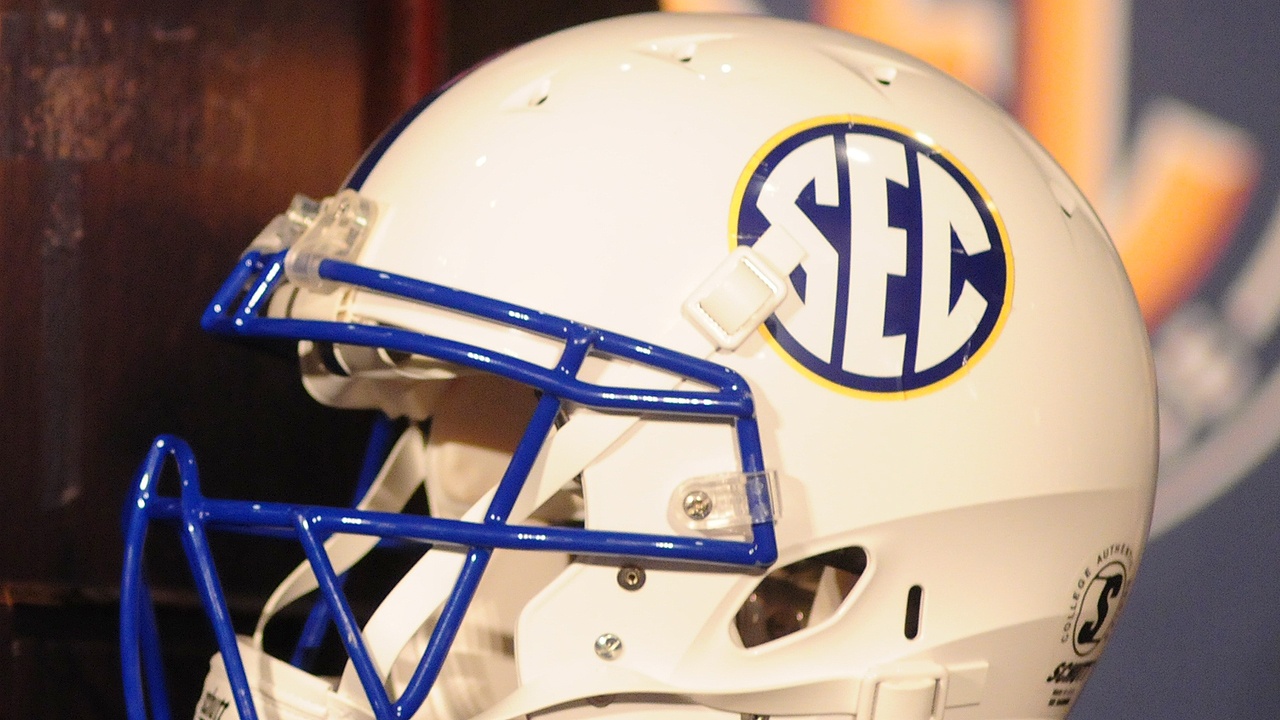
Photo by Andrew Kilzer, TexAgs
Texas A&M Football
Eight reasons the SEC will win No. 8 in 2013
Perhaps a lemniscate should be added the Southeastern Conference’s logo this football season. After all, the lemniscate is a sideways figure-eight that is used as the symbol for infinity.
Coincidentally, the SEC is seeking to push its streak of football national championships to eight consecutive seasons. The way things are going — Alabama’s 42-14 victory over Notre Dame, for example — it seems that SEC streak may be infinite.
Of course, the idea of continued SEC football dominance would surely be derided in college towns with big-time football programs like Columbus, Eugene, Clemson and Norman. Yet, here are eight factors that indicate in 2013 the SEC will produce a football national champion for the eighth straight season.
And why that streak may go on for infinity.
 Andrew Kilzer, TexAgs
The SEC features the nation's best collection of coaches, including the college football world's current king.
{"Module":"photo","Alignment":"right","Size":"large","Caption":"The SEC features the nation\u0027s best collection of coaches, including the college football world\u0027s current king.","MediaItemID":19780}
1. The coaches factor. Prior to the 2012 season, The Sporting News ranked all 124 FBS head coaches. Alabama’s Nick Saban, LSU’s Les Miles, South Carolina’s Steve Spurrier, Wisconsin’s Bret Bielema and Georgia’s Mark Richt were all ranked in the top 15.
Andrew Kilzer, TexAgs
The SEC features the nation's best collection of coaches, including the college football world's current king.
{"Module":"photo","Alignment":"right","Size":"large","Caption":"The SEC features the nation\u0027s best collection of coaches, including the college football world\u0027s current king.","MediaItemID":19780}
1. The coaches factor. Prior to the 2012 season, The Sporting News ranked all 124 FBS head coaches. Alabama’s Nick Saban, LSU’s Les Miles, South Carolina’s Steve Spurrier, Wisconsin’s Bret Bielema and Georgia’s Mark Richt were all ranked in the top 15.
Bielema is now at Arkansas, so that’s five SEC coaches in the top 15. Vanderbilt’s James Franklin was also mentioned at No. 25.
Athlon Sports did a similar list and ranked seven current SEC coaches among its Top 25. Texas A&M’s Kevin Sumlin was not included, but after last season’s 11-2 finish and a blowout of Oklahoma in the Cotton Bowl, he would undoubtedly be on an updated list.
Maybe Ole Miss’ Hugh Freeze would, too.
2. The recruiting factor. Florida, Georgia and Texas are among the country’s most fertile states (along with California and Ohio) for producing elite high school football players.
Of course, all three are now SEC states.
According to a popular recruiting service, SEC states produced 132 of the nation’s top 250 prospects in 2013. Of those, 77 signed with SEC programs.
Further, eight SEC recruiting classes in 2013 were among the nation’s top 12. Six more were among the top 30. In fact, the 2010, 2011 and 2012 recruiting rankings all listed eight SEC teams in the Top 20.
3. The Gulf of Mexico factor. Jumbo shrimp may be the only commodity more plentiful along the gulf coast than national championships. The SEC’s streak of national championships was established by teams in states that border the gulf — Florida in 2006 and ’08; LSU in 2007; Auburn in 2010 and Alabama in 2009, ’11 and ’12.
Actually, the last national championship team outside the SEC was Texas, which, of course, borders the Gulf of Mexico.
Furthermore, nine of the past 10 national championships were won by teams in states that border the gulf (LSU also won in ’03).
Southern California bucked the trend in 2004. However, the undefeated Trojans won the championship in the state of Florida. Also, Auburn was undefeated that year, but was denied a chance to play for the national championship by the flawed BCS system.
4. The preseason rankings factor. Some don’t like preseason rankings, but they often identify the most powerful teams.
In five of the past six seasons the national champion was ranked among the Associated Press preseason top five. Only Auburn, which was No. 22 in 2010, didn’t start out that high.
Preseason rankings won’t be released until August, but several “early bird” preseason projections have Alabama, Texas A&M and Georgia included among the top five. South Carolina and Florida are often listed among the Top 10.
By the way, Florida was preseason No. 7 when it won the national championship in 2006.
5. The talent factor. Four of the last six Heisman Trophy recipients played in the SEC, including Texas A&M’s Johnny Manziel, who was the first freshman in history to win the prestigious award.
Not impressed? Well, consider that in the past two NFL drafts 23 players from current SEC programs were selected in the first round. That more than doubles any other conference.
Also, the latest ESPN 2013 mock draft projects 13 SEC players as first round selections. No other conference has more than six.
What about players that will be competing in the SEC in 2013? Well, WalterFootball.com already has posted a 2014 mock draft, which projects a dozen SEC players taken in the first round.
 Andrew Kilzer, TexAgs
SEC defenses are stocked with the nation's best talent and honed through the conference's fierce competition.
{"Module":"photo","Alignment":"left","Size":"large","Caption":"SEC defenses are stocked with the nation\u0027s best talent and honed through the conference\u0027s fierce competition.","MediaItemID":21650}
6. The defense factor. Seven SEC teams — half the conference — ranked among the nation’s top 26 in scoring defense last season. The 26th team was Texas A&M, which in the Cotton Bowl faced Oklahoma, one of the country’s highest-scoring teams. The Aggies allowed just 13 points in a blowout victory.
Andrew Kilzer, TexAgs
SEC defenses are stocked with the nation's best talent and honed through the conference's fierce competition.
{"Module":"photo","Alignment":"left","Size":"large","Caption":"SEC defenses are stocked with the nation\u0027s best talent and honed through the conference\u0027s fierce competition.","MediaItemID":21650}
6. The defense factor. Seven SEC teams — half the conference — ranked among the nation’s top 26 in scoring defense last season. The 26th team was Texas A&M, which in the Cotton Bowl faced Oklahoma, one of the country’s highest-scoring teams. The Aggies allowed just 13 points in a blowout victory.
But that’s nothing new for SEC defenses.
Ohio State averaged 34.6 points in 2006, but managed only 14 points in a 41-14 championship game loss to Florida. And one of those touchdowns came on the opening kickoff return.
Oklahoma led the nation with a 51.14 scoring average in 2008. The Sooners scored 14 points in a title game loss to Florida.
Oregon led the nation with a 47-point average in 2010. The Ducks lost, 22-19, to Auburn in the championship game.
See a trend?
7. The choke factor. Several times over the past seven seasons, an SEC team wouldn’t even have been in the championship game if teams from other conferences hadn’t choked in big games.
You want examples? Here you go:
8. The Ohio State factor. The Buckeyes were undefeated last season, return most of their starters and are led by former Florida coach Urban Meyer. Therefore, most college football observers project Ohio State as the non-SEC team most likely to reach the championship game.
History shows that would benefit the SEC, which has dominated the Big Ten in general — and Ohio State in particular.
The SEC is 7-3 vs. the Big Ten in bowl games over the past three years, but is even more dominant against Ohio State. The Buckeyes are just 1-10 all-time in bowl games against SEC teams. Technically, they’re 0-10, because their 31-26 Sugar Bowl victory over Arkansas in 2010 was vacated as part of massive NCAA sanctions.
The Buckeyes are also 0-2 in championship games against the SEC, with lopsided losses to LSU (38-24) in 2007 and to Florida (41-14) in ’06.
Based on past performance, if Ohio State reaches the championship game, expect an eighth-straight national title for the SEC. And if the Buckeyes continue to reach championship games afterward, that SEC streak just may go on for infinity.
Coincidentally, the SEC is seeking to push its streak of football national championships to eight consecutive seasons. The way things are going — Alabama’s 42-14 victory over Notre Dame, for example — it seems that SEC streak may be infinite.
Of course, the idea of continued SEC football dominance would surely be derided in college towns with big-time football programs like Columbus, Eugene, Clemson and Norman. Yet, here are eight factors that indicate in 2013 the SEC will produce a football national champion for the eighth straight season.
And why that streak may go on for infinity.
 Andrew Kilzer, TexAgs
The SEC features the nation's best collection of coaches, including the college football world's current king.
{"Module":"photo","Alignment":"right","Size":"large","Caption":"The SEC features the nation\u0027s best collection of coaches, including the college football world\u0027s current king.","MediaItemID":19780}
Andrew Kilzer, TexAgs
The SEC features the nation's best collection of coaches, including the college football world's current king.
{"Module":"photo","Alignment":"right","Size":"large","Caption":"The SEC features the nation\u0027s best collection of coaches, including the college football world\u0027s current king.","MediaItemID":19780}
Bielema is now at Arkansas, so that’s five SEC coaches in the top 15. Vanderbilt’s James Franklin was also mentioned at No. 25.
Athlon Sports did a similar list and ranked seven current SEC coaches among its Top 25. Texas A&M’s Kevin Sumlin was not included, but after last season’s 11-2 finish and a blowout of Oklahoma in the Cotton Bowl, he would undoubtedly be on an updated list.
Maybe Ole Miss’ Hugh Freeze would, too.
2. The recruiting factor. Florida, Georgia and Texas are among the country’s most fertile states (along with California and Ohio) for producing elite high school football players.
Of course, all three are now SEC states.
According to a popular recruiting service, SEC states produced 132 of the nation’s top 250 prospects in 2013. Of those, 77 signed with SEC programs.
Further, eight SEC recruiting classes in 2013 were among the nation’s top 12. Six more were among the top 30. In fact, the 2010, 2011 and 2012 recruiting rankings all listed eight SEC teams in the Top 20.
3. The Gulf of Mexico factor. Jumbo shrimp may be the only commodity more plentiful along the gulf coast than national championships. The SEC’s streak of national championships was established by teams in states that border the gulf — Florida in 2006 and ’08; LSU in 2007; Auburn in 2010 and Alabama in 2009, ’11 and ’12.
Actually, the last national championship team outside the SEC was Texas, which, of course, borders the Gulf of Mexico.
With Texas A&M now
included, the SEC now can claim the entire Gulf Coast as its territory.
Furthermore, nine of the past 10 national championships were won by
teams in states that border the gulf (LSU also won in ’03).
{"Module":"quote","Alignment":"left","Quote":"With
Texas A&M now included, the SEC now can claim the entire Gulf Coast
as its territory. Furthermore, nine of the past 10 national
championships were won by teams in states that border the gulf (LSU also
won in ’03). ","Author":""}
With Texas A&M now included, the SEC now can claim the entire Gulf Coast as its territory.Furthermore, nine of the past 10 national championships were won by teams in states that border the gulf (LSU also won in ’03).
Southern California bucked the trend in 2004. However, the undefeated Trojans won the championship in the state of Florida. Also, Auburn was undefeated that year, but was denied a chance to play for the national championship by the flawed BCS system.
4. The preseason rankings factor. Some don’t like preseason rankings, but they often identify the most powerful teams.
In five of the past six seasons the national champion was ranked among the Associated Press preseason top five. Only Auburn, which was No. 22 in 2010, didn’t start out that high.
Preseason rankings won’t be released until August, but several “early bird” preseason projections have Alabama, Texas A&M and Georgia included among the top five. South Carolina and Florida are often listed among the Top 10.
By the way, Florida was preseason No. 7 when it won the national championship in 2006.
5. The talent factor. Four of the last six Heisman Trophy recipients played in the SEC, including Texas A&M’s Johnny Manziel, who was the first freshman in history to win the prestigious award.
Not impressed? Well, consider that in the past two NFL drafts 23 players from current SEC programs were selected in the first round. That more than doubles any other conference.
Also, the latest ESPN 2013 mock draft projects 13 SEC players as first round selections. No other conference has more than six.
What about players that will be competing in the SEC in 2013? Well, WalterFootball.com already has posted a 2014 mock draft, which projects a dozen SEC players taken in the first round.
 Andrew Kilzer, TexAgs
SEC defenses are stocked with the nation's best talent and honed through the conference's fierce competition.
{"Module":"photo","Alignment":"left","Size":"large","Caption":"SEC defenses are stocked with the nation\u0027s best talent and honed through the conference\u0027s fierce competition.","MediaItemID":21650}
Andrew Kilzer, TexAgs
SEC defenses are stocked with the nation's best talent and honed through the conference's fierce competition.
{"Module":"photo","Alignment":"left","Size":"large","Caption":"SEC defenses are stocked with the nation\u0027s best talent and honed through the conference\u0027s fierce competition.","MediaItemID":21650}
But that’s nothing new for SEC defenses.
Ohio State averaged 34.6 points in 2006, but managed only 14 points in a 41-14 championship game loss to Florida. And one of those touchdowns came on the opening kickoff return.
Oklahoma led the nation with a 51.14 scoring average in 2008. The Sooners scored 14 points in a title game loss to Florida.
Oregon led the nation with a 47-point average in 2010. The Ducks lost, 22-19, to Auburn in the championship game.
See a trend?
7. The choke factor. Several times over the past seven seasons, an SEC team wouldn’t even have been in the championship game if teams from other conferences hadn’t choked in big games.
You want examples? Here you go:
- In 2006, USC was second in the BCS standings and appeared headed to face Ohio State in the championship game. Instead, the Trojans were upset, 13-9, by UCLA in the regular season finale. Florida went to the championship game. Of course, Florida won.
- In 2007, Missouri and West Virginia were first and second in the BCS standings. But on the first weekend of December, Missouri lost to Oklahoma in the Big 12 championship game and West Virginia was upset by Pitt. That cleared the way for two-loss LSU to get into the championship game. Of course, LSU won.
- The tendency for teams in other conferences to choke has helped the SEC maintain a stranglehold on the national championship. {"Module":"quote","Alignment":"right","Quote":"The tendency for teams in other conferences to choke has helped the SEC maintain a stranglehold on the national championship.","Author":""}In 2011, the script was a little different. Oklahoma State was second in the BCS standings in mid-November and figured to face LSU for the championship. However, the Cowboys were upset by Iowa State. That opened the way for Alabama to face LSU in an all-SEC championship game.
- In 2012, Alabama was fourth in the BCS standings in mid-November and appeared out of the championship discussion. Then, on Nov. 17, No. 1 Kansas State was blown out by Baylor and No. 2 Oregon fell to Stanford. That propelled Alabama into the championship game against Notre Dame. Of course, Alabama won.
8. The Ohio State factor. The Buckeyes were undefeated last season, return most of their starters and are led by former Florida coach Urban Meyer. Therefore, most college football observers project Ohio State as the non-SEC team most likely to reach the championship game.
History shows that would benefit the SEC, which has dominated the Big Ten in general — and Ohio State in particular.
The SEC is 7-3 vs. the Big Ten in bowl games over the past three years, but is even more dominant against Ohio State. The Buckeyes are just 1-10 all-time in bowl games against SEC teams. Technically, they’re 0-10, because their 31-26 Sugar Bowl victory over Arkansas in 2010 was vacated as part of massive NCAA sanctions.
The Buckeyes are also 0-2 in championship games against the SEC, with lopsided losses to LSU (38-24) in 2007 and to Florida (41-14) in ’06.
Based on past performance, if Ohio State reaches the championship game, expect an eighth-straight national title for the SEC. And if the Buckeyes continue to reach championship games afterward, that SEC streak just may go on for infinity.
Never miss the latest news from TexAgs!
Join our free email list

